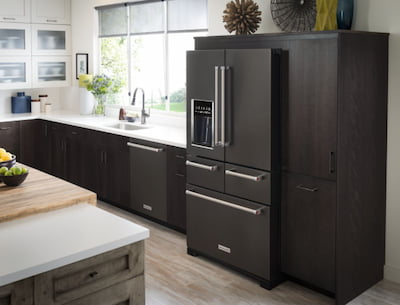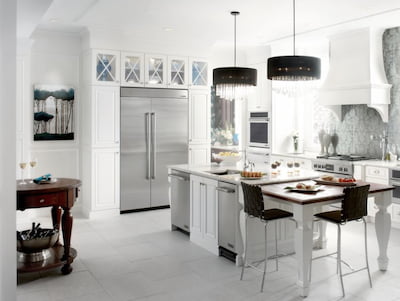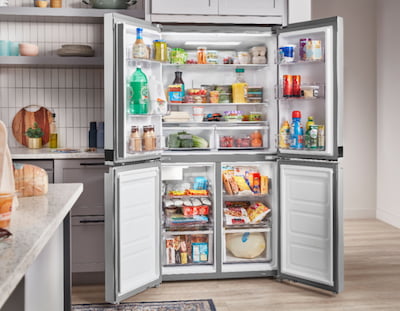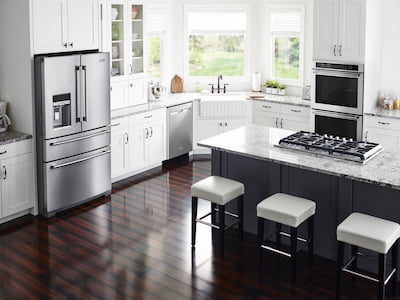.png)
.png)
Search By Square Foot
• Up to 1000 Sq Ft
• 1001 - 1500 Sq Ft
• 1501 - 2000 Sq Ft
• 2001 - 2500 Sq Ft
• 2501 - 3000 Sq Ft
• 3001 - 3500 Sq Ft
• 3501 - 4000 Sq Ft
• 4001 - 4500 Sq Ft
• 4501 - 5000 Sq Ft
• 5001 Sq Ft And Up
Search By Square Foot
• Up to 1000 Sq Ft
• 1001 - 1500 Sq Ft
• 1501 - 2000 Sq Ft
• 2001 - 2500 Sq Ft
• 2501 - 3000 Sq Ft
• 3001 - 3500 Sq Ft
• 3501 - 4000 Sq Ft
• 4001 - 4500 Sq Ft
• 4501 - 5000 Sq Ft
• 5001 Sq Ft And Up
by Rachel Lyon, Editorial Director for The House Designers®
Arguably the most important part of the kitchen, the refrigerator you choose will have a major impact on the look and feel of the space. Do you know what you want? This appliance used to give you few options, but now there are so many you could get overwhelmed comparing different models. Familiarize yourself with the possibilities so you can confidently purchase the best refrigerator for your needs!

Standard vs Counter Depth
A standard refrigerator is between 30 and 36 inches deep, which usually extends beyond cabinetry and countertops when the fridge is installed against a wall. This means it takes up floor space, and the swing of the door goes even farther out, so you have to place the refrigerator very consciously to maintain the flow of your kitchen.
Countertops—and countertop-depth refrigerators—tend to be between 24 and 25 inches from the back wall to the front edge. To make up for the significant reduction in depth, these models are often offered in wider and/or taller dimensions to ensure you still get about the same amount of volume. Countertop-depth fridges are low profile to preserve more of your floor space and reduce potential door swing interference, but many people just prefer the neater look overall.

Freestanding vs Built-In
Freestanding refrigerators are the most common choice and come in both standard- and counter-depth models to fit different aesthetic needs. Most homeowners select them because they are less expensive for both the fridge itself and for installation, because they don’t require the custom cabinetry that built-in refrigerators do. Shop for the size your kitchen was designed for and it should just fit neatly in the designated spot. If you ever need to move the fridge, just roll it out and be on your way!
Built-in refrigerators are popular for luxury homes because they have a chic, seamless, and professional look. As such, you’ll find them in standard and larger widths made to fit expansive kitchen designs. If you want a built-in fridge, be prepared to tell your cabinet maker the exact dimensions early on to ensure everything fits together as intended. You and your builder have to be proactive to get the continuous final picture that draws people to this option in the first place.

Adjustability
There are very few one-size-fits-all solutions, so don’t settle for a fridge that doesn’t serve your needs. The right interior layout depends on your groceries—you may want to invest in more or better crisper drawers if you buy a lot of produce, full-width shelves if you often store platters, etc. Always take a look inside refrigerators to see what they offer in terms of physical and functional adjustability; you should be able to move shelves to create the space you need in the moment and change settings to keep your groceries fresher for longer. Just think about every day and special occasions—sometimes you stock up on small snacks, and sometimes you have to keep a massive dish cool. Most of us only have one fridge, so it has to be flexible!

Extra Functions
Finally, take some time to explore the specifics that set each refrigerator apart—you’ll probably be surprised by the diversity! From features like colored interiors and LED lighting designed to make produce pop, to tailored settings that put you in greater control of the temperature and humidity in every section, to soft-close drawers that upgrade the feel of the crispers, to slide-out shelves that improve accessibility, refrigerators can provide so much more than the basics these days. Take stock of the possibilities and decide which functions are most important to you!
Whatever sort of refrigerator you’re in the market for, you’ll find great options with Whirlpool®, Maytag®, KitchenAid®, and JennAir® across all price points. Discuss your wants and needs with your builder—professionals stay on top of what’s new and in-demand, can give advice based on your goals, and can often get you a discount if you buy appliances through them!